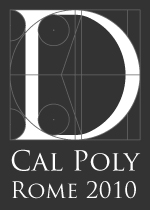Movimento, Sfondo, e Oggetti di Roma
In a city full of monuments, none of Roma’s iconic buildings are as disliked as the Monumento Vittorio Emanuele III. Nick-named “the wedding cake” and , “the typewriter”, the massive marble structure has attracted much criticism. Its construction involved removing a medieval neighborhood and carving away most of the north face of Capitoline Hill. It now sits, glaringly white, in the center of Rome, standing out from its surrounding context. Emerging from the Jewish Ghetto, the building seems like a sore thumb, inherently out of place, but to see how it truly effected the city, one must climb to the top of the cake.
Moving up above most of the winding medieval fabric of Roma, the top terrace of the monument gives the viewer a much different vantage point of the city than from the streets. The height provides cityscape views and most visitors can be seen pointing out recognizable domes and towers standing out of the dense urban tapestry. However, the perception from the monument isn’t only a cityscape – at the base of the cake, a constant pulse of movement distracts the eye. At a similar disproportionate scale, Piazza Venezia at the base of the monument facilitates a continuous stream of circling cars and rivers of people. In addition to the vibrant color, the traffic creates a bombardment of sounds. This boiling soup of activity greatly contrasts the seeming stillness of the city, effecting greatly the cityscape.
What is discovered is that the monument acts as an example of Gestalt theory. The movement in the foreground greatly changes ones perception of the city behind. Streams of color, movement, and sounds deeply juxtaposes the city, making it seem like a static, desaturated paint – a set background to the stage of action that ensues around the Piazza that directs traffic below. Slowly, most of the buildings begin merging, their colors and shapes blurring into a continuous two-dimensional image. However, a few buildings remain apart from this sea of urbanity – a select few monuments. These buildings become iconic objects in the cityscape, standing out due to their scale and the previous knowledge of their importance. Thus the wedding cake goes beyond belittling it’s immediate surroundings – it reduces these incredible monuments from centers of history, action, and intrigue to mere iconic objects.

